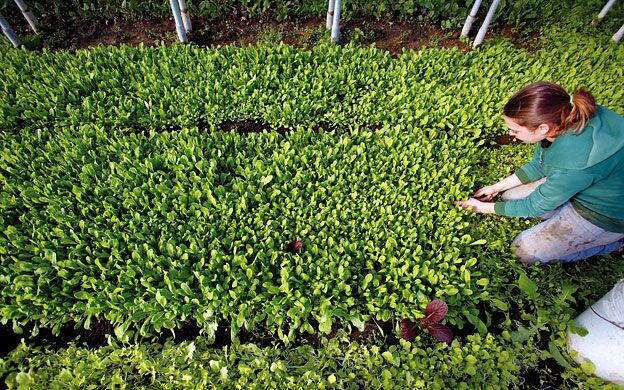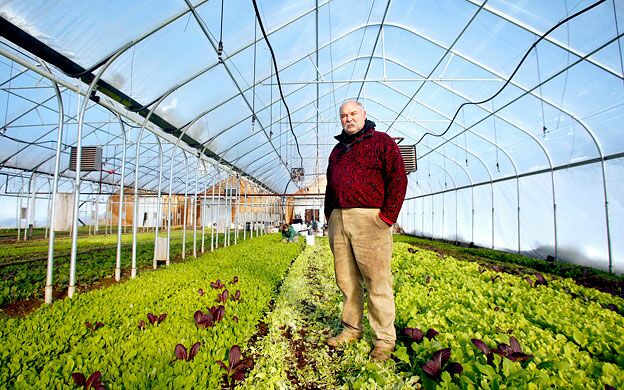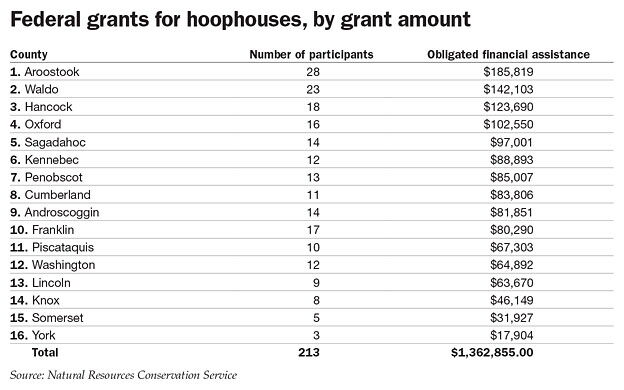Grants promote year-round produce sales
On the kind of cold December day that usually finds farmers looking at seed catalogs and dreaming of spring, Ralph Turner is welcoming customers to his greenhouses at Laughing Stock Farm in Freeport. As he talks, customers come round to pick up their weekly produce shares, which include traditional storage crops like potatoes and onions, but also fresh salad greens, baby radishes and baby carrots. Turner is among a growing number of Maine farmers who use greenhouses and hoophouses to continue the growing season well into the winter, if not year-round.
Winter growing is an essential part of Turner's business plan, as he can sell produce at a premium to restaurants hungry for local produce during the cold months of the year.
“It's a year-round job and it provides a steady year-round income, which is nice to have,” says Turner.
Year-round agriculture among Maine farmers has spiked in recent years, according to state agricultural experts. Although still a small part of the state's overall agricultural farming landscape, the winter produce market is growing at a fast rate. In the last three years, 213 Maine farms have taken advantage of a government grant program to build hoophouses (also called high tunnels) to grow produce, according to data from the Maine office of the Natural Resources Conservation Service. And the number of winter farmers' markets in Maine has doubled in the last five years, with 25 operating last winter, according to Colleen Hanlon-Smith, president of the Maine Federation of Farmers' Markets.
When the University of Maine Cooperative Extension hosted meetings for winter growers a decade ago, only seven or eight farmers would attend, says Mark Hutton, a UMaine vegetable specialist at HighMoor Farm in Monmouth. All of those growers were selling to restaurants. Now, meetings are crowded with winter growers and those who want to grow in the winter.
“We just talk about winter growing,” Hutton says. “It's just part of the landscape now.”
Coming into its own
Four-season farming pioneer Eliot Coleman has noticed the change, as well, on the Blue Hill Peninsula. The author of well-known books on year-round gardening, Coleman was used to being an outlier in the modern agricultural world. Now, he's got a lot of company at regional farming conferences, and the White House garden has even adopted some of his winter growing methods. He also notices that four-season growing has taken root on the Blue Hill Peninsula.
“The idea started slowly, but it has suddenly taken off,” Coleman says.
Winter growing provides year-round income and can provide premium prices for produce, Coleman says. Spinach that would sell for $6 a pound in the summer can sell for twice that at winter farmers' markets. Coleman tries to keep his prices as low as possible because he likes the idea of feeding his community, and the Maine market for winter produce customers often is limited to restaurants and local-food devotees.
“If we weren't competing with California, it would be easier,” Coleman says.
No new technology is driving the uptick in winter farming; there isn't a new plastic that keeps in the heat better or a new seed genetically altered to germinate in December. Much of the technology being used has been around for more than 100 years.
“We're really re-creating a world that existed 50, 60, 70 years ago,” Coleman says.
Instead, a convergence of trends and circumstance has fueled the growth in winter growing, says Melissa White Pillsbury, organic marketing coordinator at the Maine Organic Farmers & Growers Association. Much of it can be attributed to the success of the local-food movement and the growth of summer farmers' markets in the state, White Pillsbury says. Those customers don't want to stop buying Maine produce once the summer ends. Small-scale Maine farmers have seen the demand and are well-positioned to take advantage.
“That's basically a safe way to grow. You have your customers clamoring for your products,” White Pillsbury says.
Another factor boosting winter farming is federal grant money administered through the Natural Resources Conservation Service. The grant is designed to help agriculture experts measure the effectiveness of using hoophouses to extend the growing season and improve soil health. Administered through two separate programs, the program provides funds for farmers to buy infrastructure to grow in the winter if they record information about crop outcomes. The U.S. Department of Agriculture hopes to see if hoophouse growing can cut down on pesticide and fungicide use and improve air and water quality, says Chris Jones, a conservation specialist with the Maine office of the NRCS.
“We may have less soil washing away, there may be that there's less nutrients washing into streams and such, there may be less use of pesticides,” says Jones. “The objective is to get a handle on that.”
To date, 213 farmers in Maine have participated in the program and received $1.36 million in grant money to build or improve hoophouse infrastructure. Aroostook County leads the way, with the most recipients of grant money, 28. Waldo County is second with 23 participants. Because of its popularity, the program was extended beyond its original three-year mandate to go through 2012 and 2013. It's unclear if it will be extended again.
Leading the way on winter growing
While Maine is not the only state where winter hoophouse has experienced a resurgence, the state's agricultural community has enjoyed the advantage of having a pioneer in year-round growing. Coleman, who bought land from homesteading paragons Helen and Scott Nearing in 1968, developed innovative ways to extend his growing season and sell greens like spinach and mache to restaurants when other farmers were done for the year. He became influential in Maine agriculture because he shared his tricks for winter growing to anyone who would listen, including local competitors. Coleman jokes that sharing his trade secrets appealed to his competitive nature to find new ways to stay in the lead.
“I'm pretty passionate about keeping this farm one step ahead of the competition,” he says.
His books on four-season gardening have long been must-reads for small-scale farmers in cold-weather climates, and every farmer interviewed for this story cited Coleman's writings as inspiration for their winter growing operations. Many adapt his strategies to fit their own business models, Hutton says. For example, while Coleman foregoes using a heat source to grow his food, arguing it is cost-prohibitive and unsustainable, Turner at Laughing Stock Farm uses recycled cooking oil to heat his greenhouses at an affordable price; the added heat allows him to grow produce quicker in the winter.
“A lot of people have taken Eliot's model and just built on it and expanded it,” Hutton says.
On the menu
The first home for winter-grown produce in Maine traditionally has been restaurants that focus on gourmet and local fare. Rich Hanson, owner of the Ellsworth restaurant Cleonice, has been buying produce from Coleman for about a decade.
Maine restaurants that appeal to local-food lovers often are hungry for winter-grown produce, but they have to walk a fine line between buying local and staying within budget. Hanson's plan to use local produce sometimes sounds a bit like he's planning a root cellar, as he puts up pesto and pasta sauce at the end of the summer to last all winter.
He also justifies buying local greens at a higher price in the winter because it cuts down on the amount of waste that the restaurant often experiences from buying greens trucked in from California. He needs to be creative to incorporate local produce at a reasonable price.
“We have foodies who are part of our regulars, but we also have to feed everyone else around here,” Hanson says.
But there is a chicken-or-the-egg tension between supply and demand when it comes to local farmers and Maine restaurants in the winter. Winter is the slow season for most Maine restaurants, says White Pillsbury, and winter farmers shouldn't assume they can find restaurants to take their produce. Meanwhile, restaurant owners say they are desperate for more of a steady and reliable supply of locally grown produce, and demand always outstrips supply, says Richard Grotton, president of the Maine Restaurant Association.
Most winter growers in Maine find it best to sell their produce in the swelling number of winter farmers' markets or through winter community-supported agriculture programs, also called CSAs. The summer CSA model has become so popular that many farmers need to get creative to compete in Maine's local-food marketplace, and winter growing is one way to change the business model, says White Pillsbury.
“With winter CSAs, the market is relatively wide open compared to the number of summer CSAs out there,” she says.
Year-round growing might have a snowball effect on the local food movement by making local food more visible for Maine consumers, says Bob St. Peter, executive director of Food for Maine's Future, a nonprofit that seeks to encourage sustainable food systems in the state. No longer is the Maine farmer a creature who comes out only in the summer.
“It normalizes local food, I guess is the way to put it,” St. Peter says.
Stabilizing operations
Some Maine farmers see year-round growing as a way to take some of the instability out of their business plans. St. Peter also runs a farm in Sedgwick, and is hoping to grow more in the winter to sell to restaurants and local winter markets. Winter farming can strengthen and stabilize Maine's agricultural system by keeping more farmers and farm workers on the farm, he says.
“I think, for the farms that are doing it, it gives them cash-flow throughout the winter and it makes it possible to not have to go off-farm for the winter,” St. Peter says. “It also makes it possible for some of them to keep their hired help for the winter. Now you can offer someone a year-round job instead of a nine-month job.”
The promise of year-round agricultural jobs was touted by state officials in announcing the creation of Backyard Farms in Madison. A hydroponic tomato-growing operation that has had strong success in the marketplace, Backyard Farms has created 200 full-time jobs, says Tim Cunniff, executive vice-president of sales for the company.
More often, winter farming jobs are created singularly on small-scale farms or with mom-and-pop operations springing up to support winter farming. David Tidwell runs a startup company called Eden House in Portland that specializes in creating affordable greenhouse kits. He's sold a few kits since creating his business in 2012, and has one regular employee who installs the greenhouses for customers. Tidwell envisions expanding his work force at good wages to make more of the kits when orders pick up.
It remains to be seen whether this resurgence in winter growing will take deep root in Maine agriculture once the NRCS grant money runs out. The number of winter farmers' markets has leveled out in the last two years, says Hanlon-Smith with the Maine Federation of Farmers' Markets. If the concept of the winter farmers' market is going to succeed away from Maine's population-dense cities, it's up to Maine consumers to come out and support the markets in steady numbers, she says.
Meanwhile, some farmers who have tried growing winter produce now are switching back to growing only traditional root crops, which require much less effort in the winter, says Hutton. “Winter growing is hard, it's cold, it's miserable,” Hutton says. “You're working out in the hoophouse, and it's warmer than outside, but not that much warmer.”
Farmers can succeed at winter growing, but they must first ensure they have a clear business plan to make such an operation work, says White Pillsbury. It's vital to grow it at a price point that the market can bear.
“You have to have really open, honest conversations with any buyer,” she says.
But if Maine farmers can find the right market and control costs, real profits can be realized, says Cunniff. It's important to create a business model that emphasizes extending the quality of produce over the length of time it's grown, he says. In growing produce in the winter, the game plan must be the same as in the summer.
“Grow a better piece of fruit, find customers who are willing to pay for it and make sure you don't grow bigger than your customer base,” he advises.
















Comments